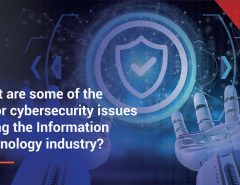Cybersecurity is a huge challenge for all firms today. The ever-increasing dependence on technology invariably makes the business susceptible to cyber attacks. Companies see cyber threats as a danger to their business that may come from the software they use. But what happens when the software itself is your business. This situation gets trickier for information technology (IT) companies. Since these companies play with code, access raw data without checks (for tests and verification) and have smart technocrats who can bypass most of the technical measures, the picture for CISO becomes very murky.
Typical cybersecurity challenges in IT
1. Tech-savvy employee base: Employees of an Information Technology company are mostly tech-savvy. Since they create the software, line by line, they consequently know how to break it. A disgruntled IT employee can do massive damage to the company and its clients without being found out for a long time.
2. Raw development tool having access to the code base: If the source code of the security features of an application is leaked, it can be used to identify gaps and that spells doom for the application security. A single virus-infected computer that has development tools can not only leak the whole source code to outside world but it can also quietly place few lines of malicious code in it.
3. Malicious code into delivered software: Software developers can write a specific piece of code that can activate itself at a specific time and under certain conditions. Such codes often cannot be detected by ordinary testing or even comprehensive testing. Software delivered with such sleeping code can spell disaster for the clients. An example could be a banks’ software that is coded to steal credit card information six months after it is activated.
4. The threat of knowledge sharing tools: This is more of a threat to intellectual property rather than direct loss of data. Software creation is a complicated procedure where software developers routinely help each other if they are stuck. Inadvertently sometimes the developers innocently share a propriety solution, that solves the problem, on the public forum. The company that spent resources on developing that solution cannot capitalize on it and faces losses.
Modern cyber threats to IT industry
The above-mentioned challenges have been there and continue to remain even today, but the organizations have taken multiple preventive steps in the same direction. However, with the evolution of more sophisticated technology, the threat landscape for IT industry is also changing. The IT industry faces huge threat from modern enemies like APT groups (Advanced Persistent Threat) and Hacktivists. APT groups steal high end technical information to reduce research and development costs required to develop tech products or solutions in their domestic market. These are then sold at highly competitive prices globally. The new age activists cum cyber criminals or hacktivists as they are popularly known are also coming up as a major threat to IT firms. Their intention is the disruption of services say of an Internet service Provider with an aim to gain attention of a wider audience towards their cause.
Read More: Setting up a business? Secure it with Seqrite EPS
Key measures to counter the challenges
While the situation may look dangerous for IT sector, it is not entirely unmanageable. Here are a few key measures that can help avoid the risks due to above factors:
1. Comprehensive security strategy: Security strategy for IT companies needs to be more elaborate. The audits and reviews must be more frequent and detailed. All the network endpoints must be continuously scanned for unauthorized access. In fact, it is not a bad idea to physically isolate the sensitive projects and control the access to that area. Organizations must ensure that network is protected with several layers of security to prevent an external breach.
2. Integrated security policy: The security policy must not be restricted only to technical infrastructure of the organization. It must include the project development safeguards as well. Various processes like testing, code review, code management and document management should be detailed in organization’s security strategy. Two separate security measures may be counter productive to the overall objective thus an integrated approach is a must.
3. Advanced threat analytics: IT organizations are a prized target amongst hackers. After all, hacking an expert carries a lot of glory with it, not to mention the treasures of confidential source code. All such organization must use the state-of-art threat analytics to ensure that they stay protected from intrusions.
4. Authentic tools with patches: All the development tools that the company uses must be licensed and updated with latest patches. The freeware or shareware tools must be thoroughly tested to ensure that they are not performing any unintended function at any time. Moreover, employees must be allowed to use only the authorized and verified versions of the tools from company’s repository and not from the internet.
Working with experts carries a risk that they often disregard the safety protocols. This means that they become the prized target for the hackers who chase fame and recognition apart from the other benefits. The IT companies must always stay prepared to encounter cyber criminals.
As an IT security partner for your business, Seqrite provides comprehensive endpoint security from advanced cyber threats. To know more, visit our website or




